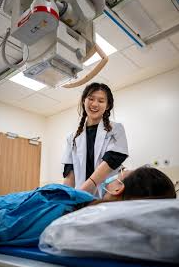The delicate balance of compassion and professionalism that defines the work of diagnostic radiographers
Joey Tan, a 29-year-old diagnostic radiographer, faces the emotional weight of her profession daily. Specialising in ultrasound, she frequently encounters cases that are as fragile as they are unnerving. Despite the emotional toll, Joey is passionate about her work. “Ultrasound is one of the most sensitive scans, detecting abnormalities in organs that might otherwise go unnoticed,” she explains.
Working at National University Hospital (NUH), Joey’s role has shaped her understanding of the healthcare sector. She received the Healthcare Merit Award scholarship from MOH Holdings (MOHH) and is nearing the end of her six-year bond with the hospital. Reflecting on her journey, she admits, “I didn’t know much about radiography when I first started, but I took the opportunity to study overseas with a close friend who shared the same interest.”
Six years after earning her degree in Radiography and Medical Imaging from Monash University in Melbourne, Joey has learned the complexities of seeing beneath the surface of the human body—where hidden stories unfold. As a diagnostic radiographer, Joey is often the first to spot serious medical conditions, although the responsibility for delivering a diagnosis rests with doctors.
“Early on, I felt an urge to tell patients what I saw, but sometimes that only caused anxiety. It’s better to analyse thoroughly before sharing anything,” she shares. Her scans sometimes reveal conditions that would have gone unnoticed without her intervention. One case, for instance, involved an 8-year-old whose bladder scan unexpectedly revealed twisted ovaries pressing against the bladder.
Part of Joey’s role also involves providing reassurance. “I try to answer patients’ questions carefully and calmly, especially when they’re anxious,” she explains. With such significant responsibility, her job requires constant vigilance and quick decision-making. The ultrasound machine might show what is hidden inside, but it’s Joey’s expertise that makes the difference.
When urgent conditions like testicular torsion or internal bleeding arise, radiographers must alert doctors immediately for possible surgery. Joey vividly recalls the moment she scanned a newborn, revealing a major brain haemorrhage that required swift action. “I felt so bad for the baby. She hadn’t done anything to deserve it,” she says. “But the best I could do was inform my colleagues and file a report.”
When dealing with terminally ill children, Joey must maintain an impartial, neutral manner to avoid diminishing the parents’ hope. These emotional challenges are part of the job, and she remembers a particularly tough moment from last year when scanning an elderly patient whose body was riddled with cancerous lesions. A few days later, she learned the patient had passed away.
Radiography can be a dangerous profession, but precautions are in place. Joey laughs as she recalls her mother’s concerns when she first started in radiography. “She thought I was being exposed to harmful radiation,” Joey says. “But the rooms are shielded with lead, and I always wear protective gear.”
Joey’s career began with general radiography, but after nearly two years of working with X-rays, she transitioned to ultrasound training. As a trainee, Joey faced challenges, especially when dealing with frustrated patients who didn’t understand why they were assigned a novice. “Some would complain, ‘Why do I have to work with a trainee? I’m not getting a discount,’” she says, but such moments did not deter her passion.
For Joey, the most rewarding aspect of her job is its diversity. “I can work in the emergency department one day and the operating theatre the next,” she says. “Imaging is often the first step in treatment, and I get to help people in a meaningful way.” Over time, Joey has developed a strong ability to communicate, especially when patients are in pain and anxious about the procedure.
Her colleague, Wei Zhou, 28, works in the Emergency Medicine department at NUH, where he regularly encounters life-threatening situations. “It’s a stark reminder that things can change in an instant,” he says. One case he remembers involved a patient who appeared fine but whose scan revealed a fractured spine that could have been fatal if not treated immediately.
Radiographers are often the first to discover serious health conditions, and this responsibility is not taken lightly. Both Joey and Wei Zhou have learned to manage their emotions. While Joey recalls feeling overwhelmed by devastating diagnoses, Wei Zhou has developed a stoic approach. “Over time, I’ve learned to ‘feel less.’ I focus on performing my duties with precision,” he says.
Wei Zhou, who works with many elderly patients, has noticed the growing issue of Singapore’s ageing population. “I see more elderly people coming in alone. When I ask about their families, many say their children are too busy to care for them,” he says. As a naturally empathetic person, Wei Zhou feels for these patients and tries to offer comfort during their brief time together.
Joey also observes how older patients tend to accept difficult news with remarkable composure. “I’ve learned that in these moments, staying calm and reassuring can be just as important as the scan results,” she adds.
Both radiographers emphasise the importance of regular health check-ups for everyone, not just the elderly. “In today’s busy world, many people neglect their health,” Joey warns. She and Wei Zhou stress the significance of early detection and regular scans in identifying potential issues before they become serious.
Despite the emotional challenges of their work, radiographers like Joey and Wei Zhou remain dedicated to their profession. Their ability to balance compassion with professionalism allows them to provide vital care and support to patients in need. As unsung heroes in the healthcare sector, radiographers are often the first to confront the fragility of life, uncovering hidden health issues that could mean the difference between life and death.








